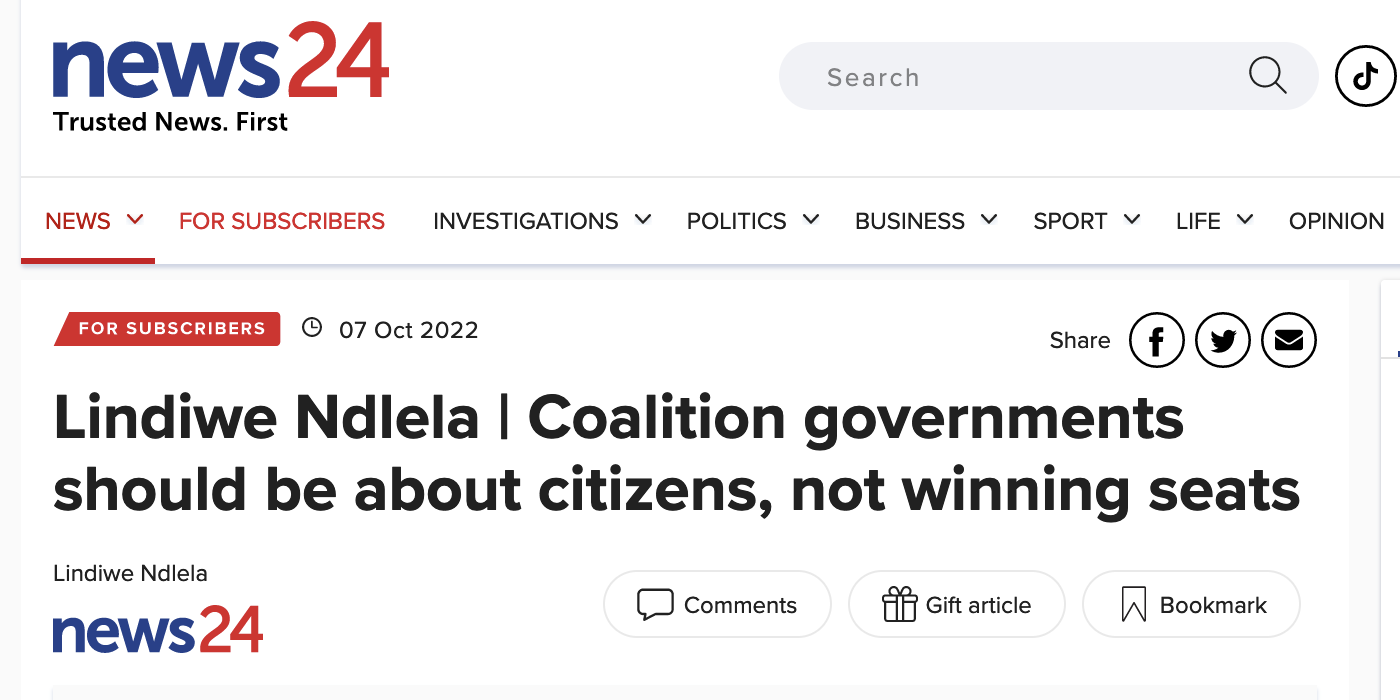by Lindiwe Ndlela
‘Unless proper care is taken to formulate citizen-centric coalition agreements, stability will remain a pipe dream and service delivery will continue to suffer,’ writes Lindiwe Ndlela.
Coalitions are not new to our lexicon. The government of national unity in 1994 was one, as were the Western Cape and KwaZulu-Natal provincial governments formed soon thereafter.
South Africa has seen an increase in the number of “hung municipalities” – upwards of 60 in the last elections on 1 November 2021 – where no party has won with an outright majority to govern alone, thus paving the way for coalitions. They are a natural part of a multiparty democracy, and as we mature as a country, we should embrace this system as we are likely to see more of them.
A cursory look at the election results since 1994, shows that support for the bigger parties at the polls is declining with the emergence of new parties. For example, both the ANC and the DA took a knock in 2019 when the support for the EFF, a newcomer in the 2014 elections, increased. The EFF eroded ANC support from 65.9% in 2009 to 62.15% in 2014.
Lessons we can learn
The experience of mature multiparty democracies in other countries shows this trend to continue with bigger and established political parties. Now speculation is rife that ANC support will slip even further below 50% in the next general elections for national and provincial government. Should this happen, coalitions at national government, and in some provinces, are a real possibility again.
But what can we learn from the coalitions in local government that have left their communities hopeless?
There were recently at least two South African delegations that set out to answer this question by observing coalitions in Denmark and Germany. I was part of the latter delegation, and from what I observed, the following were major contributors to stable coalition governments.
First, the party with the most votes almost always forms the coalition. This makes for stability as there would then be fewer parties in the coalition, which fulfils the principle of a “minimal winning coalition” – the less parties you need to govern, the better.
It is equally important that the coalition is safe from collapsing should one party decide to pull out. Thus, a “grand coalition” is made up of at least three parties with sizeable votes. And what normally keeps these coalitions together throughout the term is trust. It should make decision-making simpler and quicker, hopefully resolving disputes as well.
Second, any relationship that lacks trust, fails, and the same is true with coalitions. Parties seeking to enter into a coalition must negotiate until they agree on key issues that will form the programme of action during the coalition or the “coalition agreement”. These issues should align with their manifestos and allow for compromises during this negotiation stage. Here, parties need to agree to disagree on matters where they cannot find concurrence.
Municipalities have 14 days to form a government, while national and provincial government have 30 days. While negotiating about which seats can be traded is part of the process, substantive policy issues are what should really inform the negotiations.
Compromise needed
Third, compromise is central to a stable coalition government. The fact that no one party has a clear mandate from voters to govern suggests that parties with similar policy positions will need to work together to form a stable government. It also infers that some compromises would have to be made to include policy positions of all the parties in the coalition so that they have a stake in governing. So again, fewer parties in a coalition make for a better and coherent government.
Fourth, the coalition agreement should be made public. While not legally binding, the agreement does provide a mechanism for voters to hold the governing coalition accountable when it is broken.
In addition, constituents are able to see what has been agreed, and this can help manage expectations when they know what will be delivered by the coalition.
In most instances, voters are in the dark about the agreements that have been reached by political parties in the current coalition government. I am a City of Johannesburg resident and have no clue of what was agreed by the recently ousted DA-led coalition or what is agreed by the incoming coalition government.
Lastly, coalitions must have a mechanism to deal with potential disagreements that might arise during the term. There has been a tendency by the parties in municipal coalitions to look to their respective national structures and to enforce a “party line” on local issues. A coalition committee comprising local leaders could offer a better solution to local problems that arise.
Placing the interest of the city before those of the party should be an overriding principle in solving municipal problems. Contrary to what we have seen in the recent failed coalitions, passing a vote of no confidence on a coalition government should be the last resort. It should be used when such a government has completely failed to deliver on its mandate to the citizens.
So far, the coalitions that have been formed are used to keep either the ANC or the DA out of power in municipalities – the so-called “anything but” approach. Less than a year since the local government elections, some of these coalitions in our metropolitan governments collapsed precisely because elements discussed above were not paid much attention.
Those coalitions that have held are threatening to come apart – with no regard for citizens and the service benefits they derive from political parties working together.
Unless proper care is taken to formulate citizen-centric coalition agreements, stability will remain a pipe dream and service delivery will continue to suffer.
– Lindiwe Ndlela is the head of programmes at the Public Affairs Research Institute. She was part of a study tour to Germany which was organised and sponsored by the Hanns Seidel Foundation.


